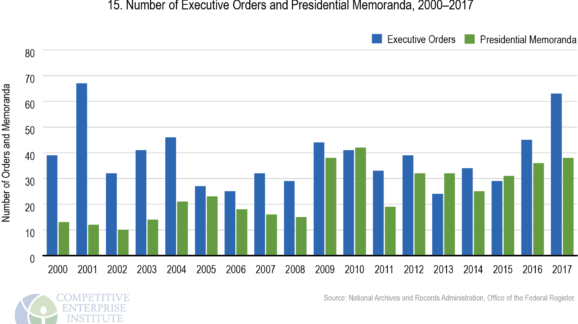Presidential Executive Orders and Executive Memoranda
Ten Thousand Commandments 2018 - Chapter 5

Executive orders, presidential memoranda, and other executive actions make up a large component of executive “lawmaking” but are not well monitored and merit heightened attention
from lawmakers.
Executive orders ostensibly deal with the internal workings and operations of the federal government. Subsequent presidents can overturn them. Their use is nothing new, and they date back to President George Washington’s administration.106 Consternation from conservatives aside, President Barack Obama’s executive order totals were not high compared with those of other presidents.
At the end of his term, Obama had issued 276 executive orders, whereas President George W. Bush’s final tally was 291, and that of President Bill Clinton was 364 (see Figure 15). President Donald Trump issued 63 orders in 2017, far outstripping anyone since Bush in 2001, that president’s highwater mark.
Memoranda are difficult to tally. They may or may not be published, depending on the administration’s own determination of “general applicability and legal effect.” George W. Bush published 131 memoranda over his entire presidency, whereas Barack Obama issued 257 that were published in the Federal Register. Bill Clinton published just 14 during his presidency. Donald Trump has issued 38 memoranda, the highest level in a single year since 2010.

The pertinent question as far as regulatory burdens are concerned is what these executive orders and memoranda are used for and what they do. Whether lengthy or brief, orders and memoranda can have significant effects, and a smaller number of them does not necessarily mean small effects. In 2014 alone, Obama memoranda created a new financial investment instrument and implemented new positive rights regarding work hours and employment preferences for federal contractors. In all, four of Obama’s executive orders directly address overregulation and rollbacks. As with the Federal Register, counts are interesting but do not tell the whole story. Obama’s Executive Order 13563 concerning regulatory review and reform was a pledge to roll back regulation.
It amounted to a few billion dollars in cuts, which were swamped by other, newly issued rules and negated by costly guidance.
In President Trump’s case, we noted a handful of his executive orders and memoranda at the beginning of this report that encompass perhaps the most aggressive attempt by the executive branch to streamline regulation.
Other key executive orders directed at regulatory restraint were President Bill Clinton’s 1993 Executive Order 12866113 and President Ronald Reagan’s Executive Order 12291, which formalized central regulatory review at OMB. Clinton’s was a step back from the heavier oversight of the Reagan order in that it sought “to reaffirm the primacy of Federal agencies in the regulatory decision-making process.”
The United States existed for many decades before a president issued more than two dozen executive orders—that was President Franklin Pierce, who served from 1853 to 1857. Orders numbered in the single digits or teens until President Abraham Lincoln and the subsequent Reconstruction period. President Ulysses S. Grant issued 217, then a record. From the 20th century onward, executive orders have numbered over 100 during each presidency and sometimes reached into the thousands. President Franklin D. Roosevelt—the longest-serving president in U.S. history, elected to four terms and having served a full three—issued 3,721 executive orders. Table 4 provides a look at executive order counts by administration since the nation’s founding through Obama.
We live in an era in which the government— without actually passing a law—increasingly specifies parameters for various economic sectors, including health care, retirement, education, energy production, finance, land and resource management, funding of science and research, and manufacturing. A prominent Obama era example is the Internal Revenue Service’s granting of waivers of the Patient Protection and Affordable Care Act’s employer mandate without regard to the statute’s language.
Counting rules and regulations, executive orders, memoranda, and other regulatory guidance gets us only so far. These alternative regulatory actions should receive more scrutiny and oversight than they do, because they have become powerful means of working around the constitutional system of government envisioned by the Framers of our Constitution: legislation made by elected representatives
Read Chapter 6 – More than 22,000 Public Notices Annually
Read Chapter 4 – Thousands of Pages and Rules in the Federal Register